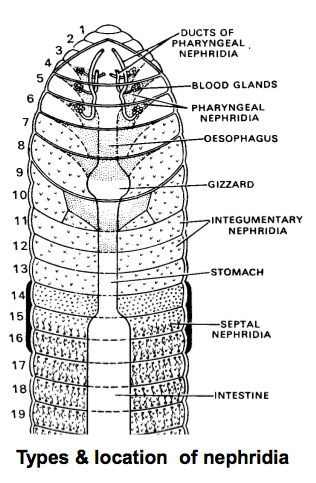
Answer
356.7k+ views
Hint: Earthworm belongs to the phylum Annelida, under class Oligochaeta and genus Lumbricus.
The major function of nephridia is the removal of waste products from the body of the earthworm. These are basically ciliated tubes that collect and excrete the waste products (surplus ions, metabolic waste, food, toxins, and other useless hormonal products) outside the body. They direct these products towards a funnel-shaped structure called nephrostomes.
Complete answer:
There are three types of nephridia found in the body of earthworm based on their location:
Septal Nephridia: These are present on both the sides of the intersegmental septa which is located behind the 15th segment. These tubes open into the intestine.
Integumentary nephridia: These are present from the 3rd segment to the last segment. These remain attached to the body wall and open into the outer environment. These are the most abundant nephridia present in earthworms.
Pharyngeal nephridia: These are present as paired tufts in 4th, 5th, and 6th segments.

Note:
The learner should have a clear distinction between protonephridia and metanephridia. The metanephridia is an excretory gland which consists of a ciliated funnel-shaped opening into the cavity of the body and it opens to the exterior environment in the body wall. It functions as an excretory gland that eliminates waste products from the body.
On the other hand, the protonephridia are dead tubules and their end parts are known as flame cells. They function as osmoregulatory organs for the entire body.
Apart from this, there are other types of nephridia present known as saccate metanephridia which are excretory glands and have the function as metanephridia. These are found in the majority of arthropods, crustaceans and arachnids.
The major function of nephridia is the removal of waste products from the body of the earthworm. These are basically ciliated tubes that collect and excrete the waste products (surplus ions, metabolic waste, food, toxins, and other useless hormonal products) outside the body. They direct these products towards a funnel-shaped structure called nephrostomes.
Complete answer:
There are three types of nephridia found in the body of earthworm based on their location:
Septal Nephridia: These are present on both the sides of the intersegmental septa which is located behind the 15th segment. These tubes open into the intestine.
Integumentary nephridia: These are present from the 3rd segment to the last segment. These remain attached to the body wall and open into the outer environment. These are the most abundant nephridia present in earthworms.
Pharyngeal nephridia: These are present as paired tufts in 4th, 5th, and 6th segments.

Note:
The learner should have a clear distinction between protonephridia and metanephridia. The metanephridia is an excretory gland which consists of a ciliated funnel-shaped opening into the cavity of the body and it opens to the exterior environment in the body wall. It functions as an excretory gland that eliminates waste products from the body.
On the other hand, the protonephridia are dead tubules and their end parts are known as flame cells. They function as osmoregulatory organs for the entire body.
Apart from this, there are other types of nephridia present known as saccate metanephridia which are excretory glands and have the function as metanephridia. These are found in the majority of arthropods, crustaceans and arachnids.
Recently Updated Pages
Fill in the blanks with suitable prepositions Break class 10 english CBSE

Fill in the blanks with suitable articles Tribune is class 10 english CBSE

Rearrange the following words and phrases to form a class 10 english CBSE

Select the opposite of the given word Permit aGive class 10 english CBSE

Fill in the blank with the most appropriate option class 10 english CBSE

Some places have oneline notices Which option is a class 10 english CBSE

Trending doubts
Fill the blanks with the suitable prepositions 1 The class 9 english CBSE

How do you graph the function fx 4x class 9 maths CBSE

When was Karauli Praja Mandal established 11934 21936 class 10 social science CBSE

Which are the Top 10 Largest Countries of the World?

What is the definite integral of zero a constant b class 12 maths CBSE

Why is steel more elastic than rubber class 11 physics CBSE

Distinguish between the following Ferrous and nonferrous class 9 social science CBSE

The Equation xxx + 2 is Satisfied when x is Equal to Class 10 Maths

Differentiate between homogeneous and heterogeneous class 12 chemistry CBSE




